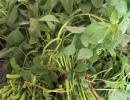 |
Amaranth
Scientific name:
Amaranthus spp.
Family:
Caryophyllales: Amaranthaceae
Local names:
Mchicha (Swahili), Terere (Kikuyu), Lidodo (Luhya), Ododo (Luo), Kelichot (Kipsigis), W'oa (Kamba), Emboga (Kisii), Kichanya (Taita), Doodo (Luganda)
Common names:
Pig weed
Pests and Diseases: Aphids
Bugs
Choanephora fruit rot
Cutworms
Damping-off diseases
Leafmining flies (leafminers)
Spider mites
Weeds
Weevils
Alternaria leaf spot, Flea beetles, Leafrollers
|
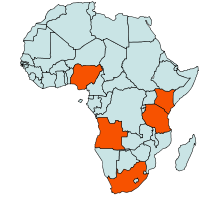 |
| Geographical Distribution of Amaranth in Africa |
Amaranth is an herbaceous annual belonging to the family Amaranthaceae with green or red leaves and branched flower stalks (heads) bearing small seeds, variable in colour from cream to gold and pink to shiny black. There are about 60 species of Amaranthus, however, only a limited number are of the cultivated types, while most are considered weedy species and hence rarely preserved. Many amaranth species are collected from the wild for subsistence, while only few are cultivated or occur as protected weeds in backyards and home gardens (Stallknecht and Schulz-Schaeffer, 1993; Ouma ; Biovision TTU, ICIPE: Keller, 2004).
Amaranth can be used as a high-protein grain or as a leafy vegetable. The seeds are eaten as a cereal grain. They are ground into flour, popped like popcorn or cooked into porridge. The seeds can be germinated into nutritious sprouts (GFU for Underutilized Species).
The leaves are cooked alone or combined with other local vegetables such as spider plant and pumpkins. The leaves are rich in calcium, iron and vitamins A, B and C, but fairly low in carbohydrates (Ouma, Biovision TTU, ICIPE.). There is no distinct separation between the vegetable and grain type since the leaves of young grain type plants can be eaten as greens (Stallknecht and Schulz-Schaeffer, 1993).
Varieties
Of all the indigenous tropical leafy vegetables, amaranth has the largest number of species and varieties. The choice of variety varies widely among regions and is dictated largely by the species available. Regardless of species, the choice of variety is influenced by individual preference for leaf colour and taste. Some of the most common commercial amaranths are selections of A. tricolor which come in various leaf colours such as white (light green), dark green, red, purple and variegated. To identify which varieties are best adapted to your location, compare during different growing seasons the yield potential of currently grown varieties with that of other available varieties (AVRDC 2003).
Nutritive Value per 100 g of edible Portion
| Raw or Cooked Grain | Food Energy (Calories / % Daily Value*) |
Carbohydrates (g / %DV) |
Fat (g / %DV) |
Protein (g / %DV) |
Calcium (g / %DV) |
Phosphorus (mg / %DV) |
Iron (mg / %DV) |
Potassium (mg / %DV) |
Vitamin A (mg / %DV) |
Vitamin C (mg / %DV) |
Vitamin B6 (mg / %DV) |
Vitamin B12 (mg / %DV) |
Thiamine (mg / %DV) |
Riboflavin (mg / %DV) |
Ash (g / %DV) |
| Amaranth grain cooked | 102 / 5% | 18.7 / 6% | 1.6 / 2% | 3.8 / 8% | 47.0 / 5% | 148 / 15% | 2.1 / 12% | 135 / 4% | - | - | 0.1 / 6% | - | 0.0 / 1% | 0.0 / 1% | 0.8 |
Amaranth grows best in loam or silty-loam soils with good water-holding capacity, but it can grow on a wide range of soil types and soil moisture levels. Amaranth can tolerate a soil pH from 4.5 to 8. (AVRDC 2003).
Amaranth is planted either by direct seeding or transplanting. The choice of planting method depends on availability of seed and labour and may also vary with the growing season. Direct seeding is appropriate when plenty of seed is available, labour is limited, and during the dry season when frequency of flooding is less. Transplanting is preferred when there is limited amount of seed, plenty of labour, and during the wet season when heavy rains and flooding are most likely to wash out seeds. Raising seedlings in a nursery and transplanting them to the field shorten the crop duration in the field, and secure a better and more uniform stand especially during the wet season.
Direct seeding
When direct seeding is used, seeds are either broadcasted or sown in rows. Broadcast seeds uniformly at the rate of 0.5 to 1.0 g/m2 of bed. Since amaranth seeds are very small, mixing seeds with sand at a ratio of 1 g seed to 100 g sand makes it easier to sow the seed and to obtain a uniform stand. Cover seed lightly with a layer of compost or rice hulls immediately after broadcasting. When plants are to be grown in rows make furrows 0.5 to1.0 cm deep and space rows 10 cm apart on the bed. Sow seeds 5 cm apart within the row and cover with a layer of compost or rice hulls. (AVRDC 2003)
Transplanting
There are two steps to transplanting:
1. Seedling production
Seedlings are grown in a seedbed, pulled and bare-root transplanted. They can also be grown in divided trays, lifted with the root ball intact and transplanted. If seedlings are started in a raised soil bed, the soil should be partially sterilised by burning a 3-5 cm thick layer of rice straw or other dry organic matter on the bed. This also adds minor amounts of phosphorus (P) and potassium (K) to the soil, which helps in the establishment of the seedlings. Broadcast the seeds lightly in a seedbed and cover them with soil. The seeds should be one 1cm deep. Cover the seedbeds with an insect-proof net to protect seedlings from pests.
2. Setting plants into the field
Transplant in the late afternoon or on a cloudy day to minimise transplant shock. Dig holes 10 cm deep on the bed using recommended spacing for the chosen variety. Place each transplant in its hole and cover the roots with soil and lightly firm. Irrigate immediately after transplanting to establish good root-to-soil contact.
Although amaranth is relatively drought tolerant, yet insufficient water will reduce yield. Water should be applied especially just after sowing or transplanting to ensure a good stand. As a rule, the plants should be irrigated if wilting occurs at noon. Another way to estimate soil moisture content is to take a handful of soil from the bottom of a 15-cm hole. Squeeze the soil. If it holds together when you release your grip, there is sufficient soil moisture; if the soil crumbles, it is time to irrigate. Irrigate thoroughly to maintain vigorous plant growth. Avoid over-irrigation, which may enhance disease development and nutrient leaching. Drip irrigation or micro-sprinkler irrigation is recommended in areas with limited water supply (AVRDC 2003)
Amaranth and other leafy vegetables have a large surface and loose water rapidly. To reduce water loss, harvest during the cooler time of day, such as early morning or late afternoon.
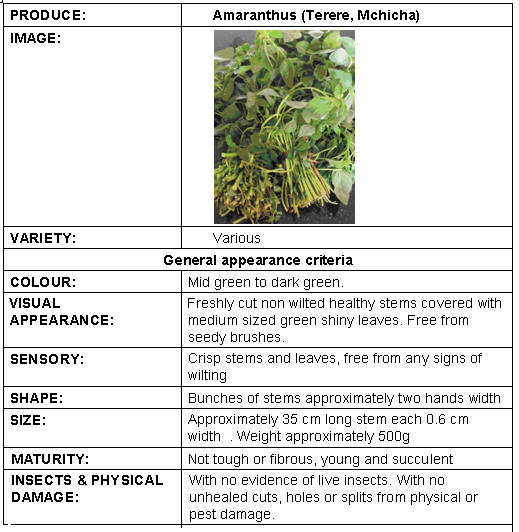 |
| © S. Kahumbu, Kenya |
Amaranth is susceptible to damage by foliar insects such as leafminers, leafroller caterpillars, cutworms, aphids, flea beetles, and mites.
An effective method of controlling insect pests is to cover the bed with a fine screen or nylon mesh netting (32-mesh or finer). (AVRDC 2003)
Aphids (Aphis spp.)
Aphids are a major pest, causing leaves to curl and become unattractive to customers.
Aphids feed by sucking plant sap. Small aphid populations may be relatively harmless, but heavily infested plants usually have wrinkled leaves, stunted growth and deformed seeds. Plants, in particular young plants, may dry out and die under heavy aphid attack. Heavy attack on older plants may cause crop loss by decreasing flower and seed production. Damage may also reduce seed viability.
- Monitor regularly the crop.
- Whenever necessary spray only affected plants (spot spraying).
- Use biopesticides that are not harmful to natural enemies (for instance neem, ashes, soapy water). In Kenya, foliar sprays with neem products such as Neemroc® (1-3%) and Neemros® water extract (50g/l) controlled the black bean aphid on vegetables (Maundu, 1997). For more information on biopesticides click here
- Conserve natural enemies. They are important in natural control of aphids. For more information on natural enemies click here
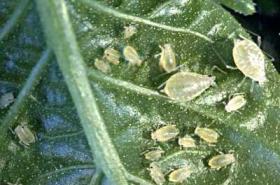
Aphids (Myzus persicae). Adult wingless females are oval-bodied, 1-2 mm in body length, of very variable colour.
© Magnus Gammelgaard
Cutworms
Cutworms attack young seedlings. First instars are 7-12mm, fully grown caterpillars are 3.5-5 cm long. The caterpillar emerges from the soil at night, encircles the plant with its body and cut through the stem of young plants just above ground level. They may also damage the plants underground. Cutworm damage causes plants to wilt and die. Cutworm damage is usually minor and does not normally warrant control. However, in severe outbreaks a young crop may be destroyed.
- Monitor damage by counting damaged and freshly cut young plants. Monitor cutworm at dawn.
- Remove and destroy cutworms.
- Prepare field and remove weeds well ahead (10-14 days) of planting the crop in the field. Ploughing exposes caterpillars to predators and to desiccation by the sun. If the field is planted soon after land preparation, some cutworms may be alive and attack the new crop.
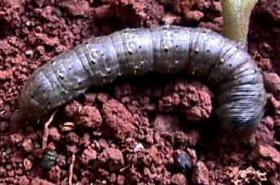
Cutworm (Agrotis sp.) Early instars are about 7-12 mm long. Fully grown caterpillars are 35-50 mm long.
© A.M. Varela, icipe
Leafminers (Liriomyza spp.)
Leafminers (Liriomyza spp.) are small flies, 1.3-1.6 mm in length. The maggot makes long, slender, white mines (tunnels) in leaves. Severely mined leaves may turn yellow and drop. Severely attacked seedlings are stunted and may eventually die. Control measures are necessary when attack is severe, especially on young plants.
- Conserve natural enemies. They are very important in natural control of leafminers. For more information on natural enemies click here
- Hand pick and destroy mined leaves.
- Whenever necessary spray the crop with neem products. Neem water extracts and neem oil give good control of leafminers. For more information on neem click here
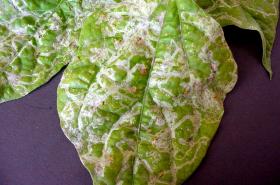
Damage on leaf by leafminers (Liriomyza spp.)
© A.M. Varela, icipe
Spider mites (Tetranychus spp., Mononychellus spp., Oligonychus spp.)
Spider mites feeding on plants may cause reduction in plant growth, flowering, and number of seeds. Damage is most severe when mites attack young plants. Mite damage may be particularly severe during the dry season.
- Avoid planting next to infested fields.
- Avoid frequent use of broad-spectrum pesticides, in particular pyrethroids; this may lead to spider mite outbreaks.
- Use overhead irrigation or wash plants with a strong jet of water to knock off mites and destroy their webs. Be sure to spray the underneath of the leaves. However, this should be done early in the day to allow the foliage to dry. Wetness of the foliage for an extended period is conducive to development of fungal diseases
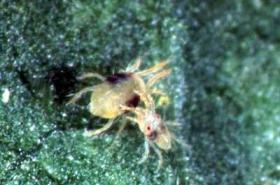
Two-spotted spider mite (Tetranychus urticae). The adult female is 0.6 mm long. The male is smaller.
© Image supplied by Warwick HRI, University of Warwick
Weevils
Several species of weevils feed on amaranth. Adult weevils feed on leaves, but the larvae (grubs) are more damaging because they bore into roots and stems, causing rotting and potentially lodging and predisposition to diseases. Stem-boring weevils such as the pigweed weevil (Hypolixus haerens) are the most damaging causing plants to wither and lodge. The adult weevil lays its eggs in branch crotches, and the larvae bore through stems to the root collar hollowing the stems. Feeding by larvae results in stems that are more susceptible to wind breakage, thus increasing crop losses. The larvae pupate in the stem.
In South Africa, attack by this weevil has been associated with extensive tissue discolouration, decay and cankers in branches, stems, and root collars of Amaranthus hybridus. This weevil has been found to be associated with fungi (mainly Fusarium spp) that cause tissue decay and a canker disease (Blodgett et al., 2004).
- Uproot and destroy attacked plants to reduce number of weevils and prevent damage to healthy plants.

Adult weevil in amaranth stem
© A. M. Varela, icipe

Weevil

Weevil

Stem canke…

Canker
Bugs
Bugs can cause severe damage to flowering head and seeds, and may be particularly damaging to grain amaranth when present in large numbers during the critical seed fill stage. They are usually of minor importance in vegetable amaranth, and no control measures are needed.
- Bugs are usually of minor importance in vegetable amaranth, and no control measures are needed.

Bugs feeding on amaranth flowering head
© A. M. Varela
See detailled information below.
Damping-off diseases (Pythium spp. Rhizoctonia solani )
The disease is caused by Pythium aphanidermatum, Rhizoctonia solani and Aphanomyces sp. Seeds may rot in the soil before emergence (pre-emergence damping-off) or seedlings may exhibit stem canker above the soil line and/or root necrosis. Affected seedlings eventually wilt (post-emergence damping-off). The disease is favoured by high soil water content and low soil temperatures. Also dense planting without sufficient aeration enhances disease development.
- Use disease-free seeds.
- Avoid over watering.
- Avoid dense planting.
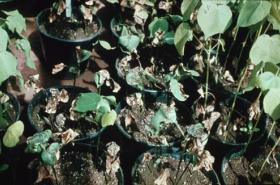
Damping-off disease (Rhizoctonia solani) (here on beans)
© Jürgen Kranz. Courtesy of Ecoport (www.ecoport.org)
Choanephora rot
Choanephora blight (also called Choanephora rot) is caused by fungus Choanephora cucurbitarium. It causes wet rot of stems and leaves. Affected plant parts have hairy appearance (silk-like threads) consisting of fungal spores. Infection is predisposed by injuries. During rainy season it can cause heavy defoliation. The disease is spread by air currents and infected seeds. Warm, moist conditions favour disease development.
- Use resistant varieties where available.
- Plant certified disease-free seeds.
- Avoid dense planting to allow sufficient aeration.
- Practise good field sanitation.
- Spray copper when the disease is observed, see more under biopesticides: copper
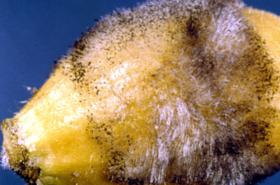
Choanephora fruit rot (Choanephora cucurbitarum) on pumpkin (Cucurbita maxima)
© Clemson University - USDA Cooperative Extension Slide Series, www.insectimages.org
Weeds
Weeds compete for light, water, and nutrients, thereby resulting in reduced yield. Thorough land preparation is the first key to effective weed control. Amaranth is small-seeded and slow to germinate - therefore, weed control is essential early in the season. A seedbed free of weed seeds allows amaranth seedlings to get a head start on the weeds and establish a canopy that can shade out emerging weed seedlings.
- Mulching is recommended to reduce weed competition, soil compaction and erosion; mulching also conserves soil moisture. Be sure the organic mulching materials are free of weed seeds. Mulching is easier to apply if the amaranth crop is transplanted, but can also be used for row-seeded crops after the seedlings reach a height of 10 to 15 cm.
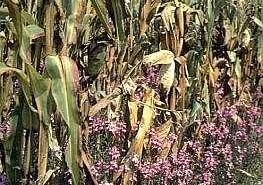
Striga (Striga hermonthica) weeds in maize field.
© David C. Nowell, EcoPort
- Amaranth (Amaranthus spp.) Gobal Facilitation Unit for Underutilized Species- Enabling deployment of underutilized species. www.underutilized-species.org
- Blodgett, J. T., Swart, W. J. and Louw, S. (2004). Identification of Fungi and Fungal Pathogens Associated with Hypolixus haerens and Decayed and Cankered Stems of Amaranthus hybridus. Plant Disease, Volume 88,(4): 333-337. www.apsjournals.apsnet.org
- EcoPort - The Consilience Engine. www.ecoport.org
- FORMAT. Forum for Organic Resource Management and Agricultural Technologies. www.formatkenya.org
- Keller, G.B. (2004). African nightshade, eggplant, spiderflower Production and consumption of traditional vegetables in Tanzania from the farmers point of view. Master thesis. Institut für Pflanzenbau in den Tropen und Subtropen. Georg-August Universität Göttingen, Fakultät für Agrarwissenschaften. www.underutilized-species.org
- Lost Crops of Africa: Volume II: Vegetables (2006). NATIONAL RESEARCH COUNCIL Division on Policy and Global Affairs Development, Security, and Cooperation. Free online-version available: National Academies Press: www.nap.edu. Amaranth: www.books.nap.edu
- Nutrition Data www.nutritiondata.com.
- Ouma, M.A. Indigenous vegetable production and utilization in Suba district, Kenya: Improving health, unlocking the wealth in Suba district. BioVision - T.T.U, ICIPE. Unpublished.
- Palada, M.C., Chang, L.C. (2003). AVRDC, International Cooperator's Guide Suggested Cultural Practices for Vegetable Amaranth. www.avrdc.org
- Stallknecht, G.F. and Schulz-Schaeffer, J.R. (1993). Amaranth rediscovered. p. 211-218. In: J. Janick and J.E. Simon (Eds.), New crops. Wiley, New York.
- Corner Shop Nairobi: cls@mitsuminet.com
- Food Network East Africa Ltd: info@organic.co.ke, +2540721 100 001
- Green Dreams: admin@organic.co.ke, +254 721 100 001
- Kalimoni Greens: kalimonigreens@gmail,com, +254 722 509 829
- Karen Provision Stores: karenstoresltd@yahoo.com, +254 20885552
- Muthaiga Green Grocers, Nairobi
- Nakumatt Supermarket: info@nakumatt.net +254 20551809
- Uchumi Supermarket: info@uchumi.com +25420550368
- Zuchinni Green Grocers, Nairobi: +254 0204448240
- Katumani Research Centre, KARI (karikatumani@yahoo.com; +2544420495).